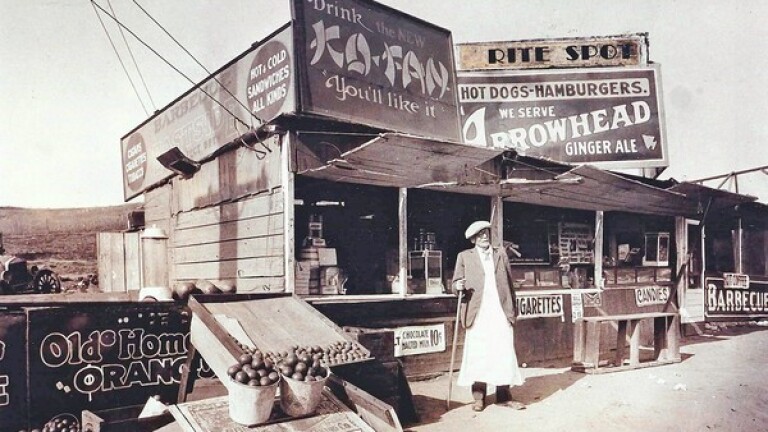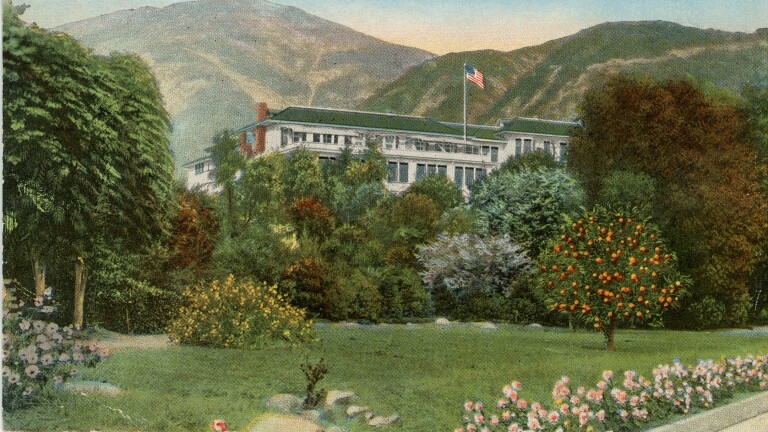The Fearless Female Who Became One of SoCal's Earliest Latina Higher Ed Teachers

In 1912, María Guadalupe Evangelina de López helped lead a group of women to demand the all-male Los Angeles County board supervisors allow a woman to be elected present of the California Teachers' Association. The headline in the Los Angeles Herald read, "Teachers Fight For Jobs Held By Men."
A woman wouldn't be elected president of CTA for another 46 years and it would be nearly a century until a Latina took the helm of the nation's largest teachers association.
De López had been fighting for women's rights and busting down societal barriers for years. She gave speeches in Spanish at Los Angeles Plaza to help gain support for the suffrage movement, served as president of the College Equal Suffrage League and graduated from the Los Angeles State Normal School (which was eventually absorbed by University of California, Los Angeles in 1919). It's believed she was the first Latina professor at UCLA.

If that wasn't enough, she helped start the public night school program for adults in Los Angeles, drove an ambulance in France during World War I, and had a side hustle with her sister teaching Spanish out of their home, said Cal Poly Pomona Professor Eileen V. Wallis who researched de López for her book "Earning Power: Women and Work in Los Angeles 1880-1920." What little mention there is of de López today focuses on her involvement with suffrage.
"But can we as Californians and Americans live up to the aspirations and ambitions of Abraham Lincoln if a group of our people is deprived, by reason of discrimination of sex, of the right to cast a ballot?" she wrote in an op-ed in the Los Angeles Herald Aug. 20, 1911, two months before California women gained the right to vote. "Can we have a democracy without women?"
Born in 1881, de López grew up in a small adobe behind the San Gabriel Mission as one of the two youngest daughters of Juan Nepomuceno López. He worked as a blacksmith among other jobs, living in the adobe with de López's mother, Guadalupe, after they emigrated from Mexico, said Cynthia L. Chamberlin, a historian at the Center for the Study of Latino Health and Culture.
Can we have a democracy without women?María Guadalupe Evangelina de López, op-ed for the Los Angeles Herald, 1911
It wasn't unusual at the time for Mexican American girls to go to school, but it was unusual to go on to higher education as de López, her sister Ernestina, and their older sister Jesusita did. The three graduated from the teaching college, Los Angeles State Normal School that later became UCLA and became teachers. De López also earned a degree in chemistry from UC Berkeley, a master's degree in Spanish from University of Southern California and, after her mother died in 1914, studied in Peru and Argentina while traveling through Central and South America, Chamberlin said.
Jesusita, who was much older than her sisters, died in her early 20s from tuberculosis after having survived harassment by the "Greek Masher" — a serial stalker who bothered her for two years until he was convicted of disturbing the peace, sentenced to 90 days in jail, and given a $200 fine, according to the Los Angeles Herald.
While their other older siblings had more traditional roles, María and Ernestina spent much of their lives as single independent working women making their own way while also furthering their culture by teaching Spanish and translating for social causes.
At 21 years old, María was already "long prominent because of her thorough knowledge of Spanish," wrote the Los Angeles Herald when she became the youngest instructor in the University of California in 1902. "...at an age when most girls have not risen above undergraduate standings."

Ernestina did some of the translations for "The Mission Play," the classic and problematic three-hour production written by John Steven McGroarty that was performed more than 3,000 times at the San Gabriel Mission Playhouse, and had a small acting role. The performing venue was right next to the López Adobe.
McGroarty was just one of the movers and shakers of the time that the intelligent and charming sisters befriended. They managed to navigate an upper middle class white society at a time when many Mexican Americans faced discrimination and women didn't have a lot of choices (de López's family lived in the adobe but didn't own the land and after de López's death the house went to Mission San Gabriel). And they didn't hide who they were or where they came from.
"She was immensely proud of being a de López," Wallis said noting that even after she got married at 38 to Hugh Lowther, she was never "Mrs. Lowther " but María López de Lowther. "She was immensely proud of her family history. She brings that up a lot."
A reporter noted in a 1911 San Luis Obispo Telegram article that she made a point of using her entire name "María Guadalupe Evangelina López." He goes on to comment on de López's "Spanish temperament" and "splendid figure." He also describes how charming and intelligent she was, "but she's pretty just the same, is full of that gentle softness and has many other traits which distinguish her from the sterner sex together with that subtle suggestion of inferiority and tender fear which only makes women more lovable."
She seems like the sort of person you say, 'You can't do that,' and she says, 'You watch me,'Cynthia L. Chamberlin, historian at the Center for the Study of Latino Health and Culture
Inferior and fearful were not words used to describe María in 1918 when she earned a commendation from France as a war hero. When the United States entered World War I in 1917, millions of women volunteered to work in various roles including Red Cross Motor Service drivers, Salvation Army "Lassies" and as doctors, nurses and nurse's aids, according to the National Park Service. Many women volunteers, like María, were also involved in the national suffrage movement.
María had moved to New York around 1916 after her time in Central and South America and worked as a high school principal. In 1917, she became certified to fly a plane and drive an ambulance — she already knew how to drive and years before had bought her own car that she would drive to Suffrage rallies around California, according to Chamberlin.
"She seems like the sort of person you say, 'You can't do that,' and she says, 'You watch me,'" Chamberlin said.
María then headed to France where she worked at a chateau converted into a hospital run by the National American Woman Suffrage Association (NAWSA). She was the only Latina in the hospital group, Chamberlin said.
María and three women from New York were stationed at a French Chateau that had been converted into a hospital when it was bombed. "Many were killed, for the bombardment lasted all night," according to the Los Angeles Herald Article, "L.A. Girl Cited for Bravery." (She was in her late 30s at the time.)

The four women "braved the fire and worked all night carrying the wounded soldiers from the besieged building." No all-night bombing was going to scare off María. She worked as an ambulance driver until the end of the war.
Shortly after she returned from France, María married Hugh Lowther, a divorced, New York professor of romance languages. By 1921, he is teaching at UCLA and, after a year at USC, so is María.
Getting married didn't slow María down. In addition to teaching Spanish and translating manuscripts at UCLA, she volunteered and held offices at various social clubs. She was President of the UCLA Faculty Women's Club (and its first Latina), helped found the Woman's City Club of Los Angeles and taught Spanish and international relations at the Ebell Club among others, according to the National Women's History Museum.
She often invited groups to her home, known as La Casa de López de Lowther Adobe, for lectures and social events. María retired from UCLA in 1947 and after that she and Lowther traveled extensively through Europe, Chamberlin said. She died in 1977 and had no children. The adobe is still there with her commendation from France on the wall, Wallis said.

Even though María fought for many of the same rights and ideals women in Los Angeles benefit from and still seek today, there are no books written about her adventures, no bench with her name on it at UCLA, and no statue in her honor in the Plaza where she gave her rousing speech in both Spanish and English about how democracy can't exist without women. Why has she been overlooked?
"Women don't get that kind of attention," said Ellen DuBois, UCLA professor emerita of history and author of "Suffrage: Women's Long Battle for the Vote." She pointed out that the first-ever sculpture depicting human women in New York's Central Park was installed in 2020 of suffragists Sojourner Truth, Susan B. Anthony and Elizabeth Cady Stanton. Before that it was only fictional figures and men.
María was doing things other women were doing at the time — working in the suffrage movement, volunteering for war service — but she did it with no other Latina woman before her, DuBois said. "She was a pioneer who broke a glass ceiling."
She was a pioneer who broke a glass ceiling.Ellen DuBois, UCLA professor emerita of history and author of "Suffrage: Women's Long Battle for the Vote"
But for whatever reason, she isn't widely chronicled as "a player in the history of Southern California when really she should," Wallis said.
Chamberlin is trying to change that. She began researching María's life as part of the year-long UCLA Centennial initiative that would highlight alumnae who made an impact on the city and the world. Chamberlin combed through historic newspaper and magazine clippings, books and government documents to piece together the details of María's fascinating life. María, class of 1899, was one of three Latinas to have been featured during Women's History Month in March 2020, but UCLA shut down due to COVID three days before the event.
Additional Reading
Eileen V. Wallis, "Earning Power: Women and Work in Los Angeles 1880-1920." University of Nevada Press, 2010
Cynthia L. Chamberlin, Giselle D. Hernández, Stephanie A. Hernández, Seira Santizo Greenwood, and David E. Hayes-Bautista, "¡Somos UCLA! (And Always Have Been); Three Latina Alumnae of the Los Angeles State Normal School." Center for the Study of Latino Health and Culture, 2020
Ellen Carol DuBois, Suffrage: Women's Long Battle for the Vote, Simon and Schuster, 2021.
Mariana Brandman, "Maria Guadalupe Evangelina de Lopez," National Women's History Museum, 2020
"50,000 Pupils Enroll in L.A. Schools; Tax Buildings' Capacity," Los Angeles Herald, 1912
"L.A. Girls Cited for Bravery," Los Angeles Herald, 1918
María de G.E. López, "Equal Suffrage of Most Vital Moment," Los Angeles Herald, 1911
Henry M. Moreno, "Short Range Chat with a Suffragette (sic)," San Luis Obispo Daily Telegram, 1911







